
Assess the risks of staying in the area where evacuation has been announced:
- death or injury as a result of shelling, collapsed or damaged buildings, fires;
- lack of water, gas, electricity, communication, access to postal, banking, administrative and social services;
- difficult or impossible access to food, medicine and medical services;
- the possibility of forced forced mobilization of men by the occupation authorities in the event of temporary occupation of the territory;
- Forced evacuation (deportation) of the population (especially children) to other regions of the occupying country by the occupying authorities;
- the closer the hostilities are, the more difficult and dangerous it is to leave, and at a critical moment, evacuation may be impossible.
After the evacuation is announced, you should contact the authorities or public organizations for assistance with evacuation.
If you cannot get there yourself, you will be evacuated directly from your home in special vehicles.
For the elderly and people with disabilities, targeted evacuation is provided - from home, with special transport and escort. Evacuation takes place upon prior request and with the person's consent.
Prepare for evacuation in advance
If your community is in danger of active hostilities, plan to leave for safe areas by personal transport, including with the help of relatives, neighbors, friends, and acquaintances. Always keep your vehicle in good condition and filled with fuel to the full tank. Also, carefully plan your departure route (depending on the area of active hostilities, check with local authorities) and determine the place of arrival in the safe zone, while considering accommodation with relatives, friends, acquaintances, relatives or in places of temporary residence.
Check with local authorities in advance to find out the address of the evacuation point and how you will get there by transport or on foot. You can also get additional advice if you have any questions about what to do in case of emergency.
Evacuation is free of charge!
Evacuation by public authorities or public organizations is carried out along a route or by address. The route is known and verified. You will be informed of it in advance. An evacuation team will meet you at the specified time with your belongings.
Prepare an emergency suitcase in advance. To ensure mobility, you should take no more than 1-2 bags of essentials per person.
Things and documents to bring with you:
- documents: documents proving identity (passport, ID card, international passport) and civil status (certificates of birth, marriage, divorce, death of relatives), education, ownership of real and personal property, medical documents, driver's license, employment record, pension certificate, military ID, etc., as well as copies of these documents, if possible
- money, bank cards, valuables;
- means of communication and separately stored phone numbers of relatives;
- duplicate keys to the house, car;
- a first aid kit assembled according to your needs;
- food for a few days - anything that can be eaten without preliminary processing, does not take up much space and is stored for a long time.
- a supply of drinking water for 1-2 days.
- hygiene products (toothbrush and toothpaste, soap, towel, toilet paper, several packages of disposable dry wipes, wet wipes). For women - intimate hygiene products. You can take a razor and a manicure set.
- Necessary personal items that you can carry on your own: in particular, a favorite toy for your child, comfortable clothes, shoes and underwear for the season, personal hygiene products and small items of important sentimental value (for example, photos of family members)
This list is not exhaustive. You can supplement it with other things, but remember that the total weight of personal belongings for each family member should not exceed 50 kg.
Attach a tag to your suitcase with your name, surname, and address. On the tag of children's things, in addition to the above, indicate the year of birth of the child.
For preschool children, put a note in your pocket with the child's name, surname, patronymic, home address, and contact information of the parents.
DO NOT bring with you:
- household appliances (TV, washing machine, microwave, etc.)
- bed linen
- carpets;
- canned food and perishable food;
- dishes
- other bulky items.
Everything is organized and safe
You will be brought to the transit center, told about the services you can receive there (including financial assistance, food and hygiene kits, counseling, legal assistance, social support, access to employment, medical, administrative and social services at the place of settlement, hotline contacts) and provided with information about the duration of your stay in the transit center. The centers are staffed by doctors, psychologists, representatives of the State Emergency Service, police, social workers, volunteers, and lawyers.
Attention! The evacuation is carried out by state authorities, local governments (OVA, district, community) and designated public organizations.
In order to avoid fraud and other risks, do not give your documents to strangers; have information about who is conducting the evacuation, the names of organizations and names of contact persons; warn relatives, acquaintances and friends about the expected evacuation route and which organization is facilitating the evacuation, etc.